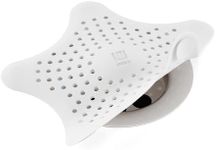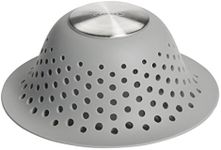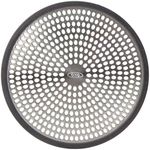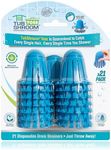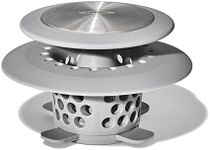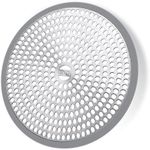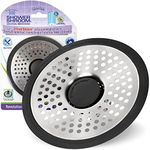Buying Guide for the Best Hair Catcher Shower Drain
Choosing the right hair catcher for your shower drain can make a big difference in keeping your pipes clear and your bathroom clean. The main goal is to prevent hair and debris from clogging your drain, which can save you from costly plumbing issues. When shopping for a hair catcher, it's important to consider how well it fits your drain, how easy it is to clean, and how effectively it traps hair without blocking water flow. Understanding the key features will help you pick a product that matches your shower setup and your cleaning preferences.MaterialThe material of a hair catcher determines its durability, flexibility, and ease of cleaning. Common materials include silicone, rubber, and stainless steel. Silicone and rubber are soft, flexible, and less likely to scratch your tub, making them easy to remove and clean, but they may wear out faster. Stainless steel is more durable and can handle frequent use, but it may be less flexible and could rust if not properly maintained. If you want something long-lasting and sturdy, stainless steel is a good choice, while silicone or rubber is better if you prefer something gentle and easy to handle.
Size and FitSize and fit refer to how well the hair catcher matches the shape and dimensions of your shower drain. Some hair catchers are universal and can fit most standard drains, while others are designed for specific shapes like round, square, or rectangular drains. It's important to measure your drain before buying to ensure a snug fit, as a poor fit can let hair slip through or cause the catcher to move around. If your drain is a standard size, a universal catcher should work, but for unique or larger drains, look for adjustable or specifically sized options.
Type (In-drain vs. Over-drain)Hair catchers come in two main types: in-drain and over-drain. In-drain catchers sit inside the drain and catch hair below the surface, making them less visible but sometimes harder to remove and clean. Over-drain catchers sit on top of the drain, making them easy to access and clean, but they may be more noticeable and can sometimes shift during use. If you want something discreet, in-drain is a good choice, but if you prioritize easy cleaning and installation, over-drain models are more convenient.
Ease of CleaningEase of cleaning is about how simple it is to remove hair and debris from the catcher. Some designs allow you to quickly lift out the catcher and rinse it, while others may require more effort to remove trapped hair. Look for catchers with smooth surfaces or removable parts, as these are generally easier to clean. If you dislike handling hair or want to minimize cleaning time, choose a design that lets you easily lift and rinse the catcher without touching the trapped debris.
Water FlowWater flow refers to how well the hair catcher allows water to drain while still trapping hair. A good hair catcher should have enough holes or slots to let water pass through freely, preventing water from pooling in your shower. Some catchers with very fine mesh can block water if they get clogged quickly, while those with larger holes may let some hair slip through. If you have thick or long hair, look for a catcher with a balance between fine mesh and adequate drainage to avoid slow water flow.
Stability and Slip ResistanceStability and slip resistance are about how well the hair catcher stays in place during use. Some catchers have suction cups or weighted edges to prevent them from moving, while others rely on their shape or material to stay put. A catcher that moves around can be annoying and less effective at catching hair. If your shower has a smooth surface, suction cups can help keep the catcher stable, while heavier or textured designs work well for most other surfaces.
